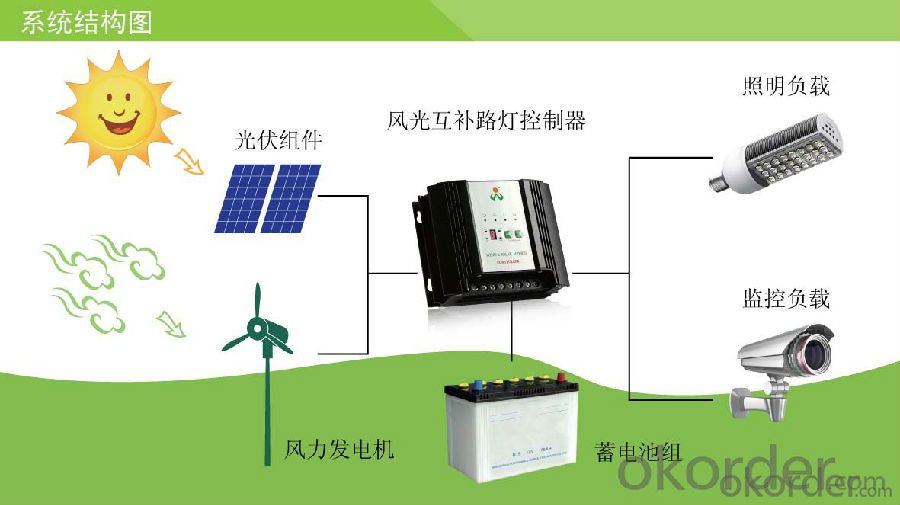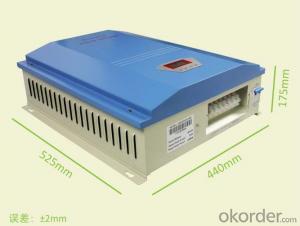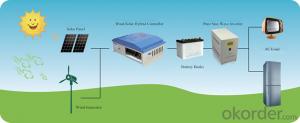Wind Solar Hybrid Controller 3KW PWM Stepless Unload Mode
- Loading Port:
- Shanghai
- Payment Terms:
- TT or LC
- Min Order Qty:
- 1 unit
- Supply Capability:
- 5000 unit/month
OKorder Service Pledge
OKorder Financial Service
You Might Also Like
I. PRODUCT INTRODUCTION
The wind/solar hybrid controller is the control device which can control wind turbine and solar panel at the same time and transform wind and solar energy into electricity then stores to the battery bank.Wind/solar hybrid controller is the most important part in off-grid system, whose performance has much effect on life expectancy and operational stability of the whole system, especially the battery expectancy. Or battery service life will be shortened by over-charge or over-discharge.
II. PERFORMANCE FEATURES
Superior military-grade components to ensure the product stability.
Perfect protection function, thus the system has higher reliability.
Check and set all operation parameters as requirement from LCD display.
Voltage limiting and current-limiting charge mode ensures battery in the best charging status.
PWM stepless unload mode, which burn the excess power into dump load, making the battery charging in best status.
III. APPLICATION AREAS
Stand alone wind/solar hybrid power station; Stand alone domestic household wind/solar hybrid power system.
Mobile communication base stations, expressway and other non-residential regions.
Coastal islands, remote mountainous, border posts for regions shortage of or without electricity.
Government demonstration projects, landscape lighting project.
IV. 3KW TECHNICAL PARAMETERS
Product Model | WWS30-48 | WWS30-96 | WWS30-110 | WWS30-120 | WWS30-220 |
Rated Battery Voltage | 48 V | 96 V | 110V | 120 V | 220 V |
Rated Wind Turbine Input Power | 3 kW | 3 kW | 3kW | 3 kW | 3 kW |
Maximum Wind Turbine Input Power | 4.5 kW | 4.5 kW | 4.5kW | 4.5 kW | 4.5 kW |
Wind Turbine Brake Current | 63 A | 32 A | 28A | 25 A | 14 A |
Rated Solar Input Power | 0.9 kW | 0.9 kW | 0.9kW | 0.9 kW | 0.9 kW |
Floating Charging Voltage | 58 V | 116 V | 133V | 145 V | 266 V |
Dimension(L x W x H) | 442×525×172 mm | ||||
Net Weight | 15kg | ||||
Display Mode | LCD | ||||
Cooling | Fan | ||||
Protection Level | IP20(Indoor) | ||||
Quiescent Current | ≤20 mA | ||||
Protection functions | Battery over charge; Battery over discharge; solar reverse charge protection; anti-reverse-connection protection; wind turbine over rotate speed protection; wind turbine over wind speed protection; wind turbine over voltage protection; wind turbine over current protection; manual brake protection; automatically brake protection; lightning protection. | ||||
Ambient Temperature | -20~+55℃ | ||||
Ambient Humidity | 0~93%, without condensing | ||||
Working humidity | ≤4000m | ||||
In order to serve our customers better. Our company can adjust parameters configuration according to customer’s requirement. | |||||

- Q:Can a solar controller be used with a solar-powered nuclear reactor?
- No, a solar controller cannot be used with a solar-powered nuclear reactor. A solar controller is designed specifically to regulate and control the charge and discharge of batteries in solar power systems. On the other hand, a solar-powered nuclear reactor uses nuclear fission to generate electricity, which operates on an entirely different principle and does not require a solar controller.
- Q:Can a solar controller be used in a solar-powered telecommunications system?
- Yes, a solar controller can be used in a solar-powered telecommunications system. A solar controller, also known as a charge controller, is an essential component that regulates and controls the flow of electricity from the solar panels to the batteries. It ensures that the batteries are charged efficiently and protects them from overcharging or excessive discharging. In a solar-powered telecommunications system, the solar controller plays a crucial role in managing the energy generated by the solar panels, ensuring reliable power supply for the communication equipment.
- Q:Can a solar controller handle power fluctuations from the inverter?
- Yes, a solar controller is designed to handle power fluctuations from the inverter. It regulates and controls the flow of electricity between the solar panels, batteries, and inverter, ensuring stable and consistent power supply even in the presence of fluctuations.
- Q:Solar controller water level display is not correct how to do
- Re-adjust the water level to control, choose their own water.
- Q:Can a solar controller be used in an agricultural solar system?
- Yes, a solar controller can be used in an agricultural solar system. The solar controller helps regulate the charging and discharging of energy from the solar panels to the batteries, ensuring optimal performance and energy efficiency. In an agricultural solar system, the solar controller can effectively manage the power supply to various components such as irrigation systems, pumps, and lighting, helping to maximize productivity and sustainability.
- Q:What is the role of a temperature sensor in a solar controller?
- The role of a temperature sensor in a solar controller is to measure the temperature of various components, such as the solar panels or batteries, and provide this information to the controller. This allows the controller to make adjustments and optimize the performance of the solar system based on the temperature conditions. For example, if the temperature exceeds a certain threshold, the controller may reduce the charging rate to prevent overheating and potential damage. Overall, the temperature sensor helps in maintaining the efficiency and safety of the solar system.
- Q:Can a solar controller be used with different types of batteries (e.g., lead-acid, lithium-ion)?
- Indeed, various batteries, such as lead-acid and lithium-ion, can be utilized alongside a solar controller. The chief purpose of solar controllers is to oversee and govern the battery charging procedure, guaranteeing that they are charged at the correct voltage and avoiding both excessive charging and insufficient charging. They possess the capability to be programmed or fine-tuned to match the distinct charging demands of diverse battery types. This adaptability empowers users to link and charge an assortment of batteries using just one solar controller, presenting a versatile and practical resolution for solar power systems.
- Q:Are solar controllers necessary for small solar panel systems?
- Yes, solar controllers are necessary for small solar panel systems. They regulate the flow of electricity from the solar panels to the battery, preventing overcharging and damage to the battery. Additionally, solar controllers help optimize the efficiency and performance of the solar panel system, ensuring maximum power generation.
- Q:What is the maximum operating altitude of a solar controller?
- The maximum operating altitude of a solar controller typically depends on the specific model and manufacturer. However, most solar controllers can operate effectively at altitudes up to 4,000 meters (13,123 feet) above sea level. It is important to refer to the product specifications or consult the manufacturer for accurate information regarding a particular solar controller's maximum operating altitude.
- Q:How does a solar controller prevent overvoltage in the battery?
- A solar controller prevents overvoltage in the battery by monitoring and regulating the charging process. When a solar panel produces electricity, it sends it to the battery for storage. However, if the solar panel generates more voltage than the battery can handle, it can lead to overcharging and damage to the battery. To prevent this, a solar controller acts as a regulator between the solar panel and the battery. It constantly monitors the voltage level of the battery and ensures that it does not exceed a certain predetermined threshold. If the battery voltage approaches or exceeds this threshold, the solar controller will automatically reduce the charging current or disconnect the solar panel from the battery to prevent overvoltage. Solar controllers employ various methods to regulate charging and prevent overvoltage. One common technique is called pulse-width modulation (PWM), where the controller rapidly switches the charging current on and off to maintain a steady voltage level. Another method is called maximum power point tracking (MPPT), which optimizes the output of the solar panel to match the battery's voltage requirements. In addition to preventing overvoltage, solar controllers also perform other important functions like temperature compensation, which adjusts the charging parameters based on the battery's temperature, and low voltage disconnect, which protects the battery from deep discharge. By effectively managing the charging process, solar controllers ensure the longevity and optimal performance of the battery in a solar power system.
1. Manufacturer Overview |
|
|---|---|
| Location | |
| Year Established | |
| Annual Output Value | |
| Main Markets | |
| Company Certifications | |
2. Manufacturer Certificates |
|
|---|---|
| a) Certification Name | |
| Range | |
| Reference | |
| Validity Period | |
3. Manufacturer Capability |
|
|---|---|
| a)Trade Capacity | |
| Nearest Port | |
| Export Percentage | |
| No.of Employees in Trade Department | |
| Language Spoken: | |
| b)Factory Information | |
| Factory Size: | |
| No. of Production Lines | |
| Contract Manufacturing | |
| Product Price Range | |
Send your message to us
Wind Solar Hybrid Controller 3KW PWM Stepless Unload Mode
- Loading Port:
- Shanghai
- Payment Terms:
- TT or LC
- Min Order Qty:
- 1 unit
- Supply Capability:
- 5000 unit/month
OKorder Service Pledge
OKorder Financial Service
Similar products
New products
Hot products
Hot Searches
Related keywords





























